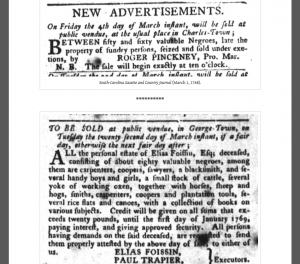What is this digital public history exhibit about?
This digital public history concerns advertisements that were printed into newspapers 250 years ago. Every day, a new image of an advertisement is posted displaying what was published in the news 250 years ago that same day. Most of these advertisements discuss slavery and slave auctions, as this was the main subject of news and advertisements at this time.
Who made it, and why?
The main contributors to this exhibit are students from Colonial America, Revolutionary America, and Public History courses at Assumption College. Every semester, new students guest contribute to this exhibit as part of their coursework. This project is administered and operated by Carl Robert Keyes, the associate professor of history at Assumption College.
What kinds of primary sources did you find?
Every post in this exhibit is a primary source, as they are images of real-life newspapers from 250 years ago.
Overall, what did the digital public history exhibit do well?
One thing that I believe this exhibit does very well is that it is easily accessible to all of it’s users. The main dashboard displays the advertisements from 250 years ago of the day you are on the website. All of the information is easily discoverable, as on the right-hand side, the user can see all recent posts, as well as all of the posts completed in the last year categorized by month. If a user has a date in mind, they can easily search for it on the right-hand side as well. All information on the website and it’s contributors can be found by clicking on the different tabs located on the top of the page. I did not find any of the information to be difficult to find, unlike many other websites I have used in the past.
Overall, what could be improved in the digital public history exhibit?
One thing that I believe can be improved on in this exhibit is the difficulty level of reading the advertisements themselves. Obviously, language has changed much from 250 years ago, from phrases, to words, and even to letters. I found it very difficult to read some of the advertisements, as the letters and words sometimes looked like other letters and words, making it hard to comprehend what the writer was trying to say. The contributors to this website can fix this problem by transcribing the text underneath the image, allowing readers to see the words far more clearly and understand what is trying to be said.
Thinking about digital humanities more broadly, what is gained, and what is lost, when representing the past through this digital public history exhibit?
One thing that is gained through this exhibit is a perspective on how both society and media has changed over time. By reading the information that is presented on this website, it is obvious how much society has changed, the number one difference being the abolished slavery. News and advertisements have completely changed, and are also more universal to include many different topics rather than just one. By simply looking at the website, the viewer can see how much media has changed from 250 years ago. During this time, newspapers were the main way to get information across to people; now, online digital media is the main way for people to access news and information. Currently, most people have access to the internet and utilize it to gain information for all different uses. Containing these images and this information on this platform allows people from all over the world to access this information easily, anywhere they want.




